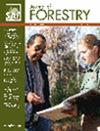美国东南部的实验森林和牧场是否代表了该地区的气候、生态系统结构和生态系统功能?
IF 1.8
3区 农林科学
Q2 FORESTRY
引用次数: 0
摘要
美国东南部有二十个森林和牧场实验点(EFRs),目前由美国农业部林务局(Forest Service)负责维护,以开展森林生态系统研究,应对生态系统管理方面的挑战。本研究的总体目标是使用多个网格数据集来评估二十个试验区在多大程度上代表了东南部森林的气候、生态系统结构和生态系统功能。EFR 相对较好地代表了整个地区气候条件的巨大变异性,但我们也发现了一些小的代表性差距。通过在树木覆盖率、叶面积指数或树冠高度相对较低的森林中建立 EFRs,可以提高这些 EFRs 对生态系统结构的代表性。目前的生态影响因子也相对较好地代表了该地区的森林生态系统功能,尽管中等和较低地上生物量和产水量的地区没有得到很好的代表。气候、生态系统结构和生态系统功能的变化趋势在该地区和 EFRs 之间基本一致。我们的研究表明,目前的 EFR 相对较好地代表了该地区,但在该地区的特定区域建立更多的 EFR 有助于更全面地评估东南部森林如何应对气候变化、干扰和管理措施。研究意义 这项横跨实验林场和东南部林区的研究填补了在更广泛的东南部林区背景下有关实验林场的气候、生态系统结构和生态系统功能的知识空白。了解整个 EFR 网络的生态系统功能和结构有助于南方研究站解决新的研究问题。我们的研究表明,目前的 EFR 很好地代表了东南部森林的气候、生态系统结构和生态系统功能。然而,在某些地区建立更多的生态影响因子有助于更全面地评估东南部森林如何应对气候变化、干扰和管理措施。本文章由计算机程序翻译,如有差异,请以英文原文为准。
Do Experimental Forests and Ranges of the Southeastern United States Represent the Climate, Ecosystem Structure, and Ecosystem Functions of the Region?
There are twenty experimental forest and range sites (EFRs) across the southeastern United States that are currently maintained by the USDA Forest Service (Forest Service) to conduct forest ecosystem research for addressing ecosystem management challenges. The overall objective of this study was to use multiple gridded datasets to assess the extent to which the twenty EFRs represent the climate, ecosystem structure, and ecosystem functions of southeastern forests. The EFRs represent the large variability of climate conditions across the region relatively well, but we identified small representation gaps. The representativeness of ecosystem structure by these EFRs can be improved by establishing EFRs in forests with relatively low tree cover, leaf area index, or tree canopy height. The current EFRs also represent the forest ecosystem functions of the region relatively well, although areas with intermediate and low aboveground biomass and water yield are not well represented. The trends in climate, ecosystem structure, and ecosystem functions were generally consistent between the region and the EFRs. Our study indicates that the current EFRs represent the region relatively well, but establishing additional EFRs in specific areas within the region could help more completely assess how southeastern forests respond to climate change, disturbance, and management practices. Study Implications This study across the experimental forests and ranges (EFRs) and the southeastern forest region fills the knowledge gap regarding climate, ecosystem structure, and ecosystem functions of EFRs in the context of the broader southeastern forest region. Understanding ecosystem functions and structures across the EFR network can help the Southern Research Station to address new research questions. Our study indicates that the current EFRs represent the climate, ecosystem structure, and ecosystem functions of southeastern forests well. However, establishing additional EFRs in certain regions could help more completely assess how southeastern forests respond to climate change, disturbance, and management practices.
求助全文
通过发布文献求助,成功后即可免费获取论文全文。
去求助
来源期刊

Journal of Forestry
农林科学-林学
CiteScore
4.90
自引率
8.70%
发文量
45
审稿时长
>24 weeks
期刊介绍:
The Journal of Forestry is the most widely circulated scholarly forestry journal in the world. In print since 1902, the mission of the Journal of Forestry is to advance the profession of forestry by keeping forest management professionals informed about significant developments and ideas in the many facets of forestry. The Journal is published bimonthly: January, March, May, July, September, and November.
 求助内容:
求助内容: 应助结果提醒方式:
应助结果提醒方式:


